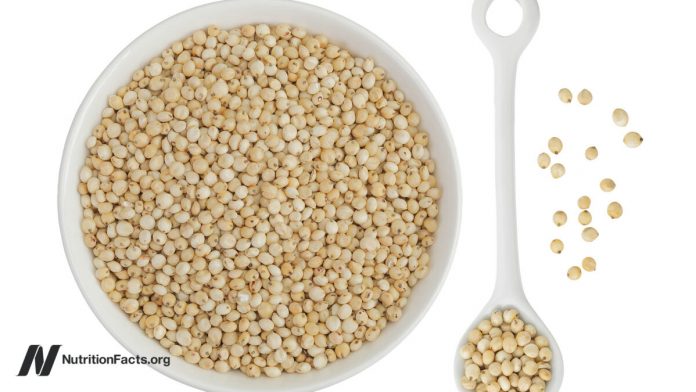Learn why sorghum is one of my favorite new grains.
“Despite playing a significant role in Africa and Asia as a staple grain, sorghum has only recently emerged as a potential human food source in the developed world.” And it isn’t just a principal grain in many parts of the world, but it’s “critical in folk medicine” traditions, too. What might its health benefits be? There are some in vitro data from test tubes and petri dishes, as well as in vivo data, meaning “within the living” in laboratory animals, but only in the last decade have we started seeing human trials.
In one study, participants were asked to eat sorghum pancakes or corn pancakes for supper every day for three weeks. Both groups saw significant, 20 to 30 percent drops in their cholesterol, but all participants were also “requested not to consume eggs and other cholesterol-boosting foodstuff,” so that may very well have played a role.
Another study used biscuits. Those eating sorghum biscuits said they felt more satiated than when they ate wheat biscuits, but that “did not translate to differences in intake at the subsequent ad-libitum [all-you-can-eat] meal.” So, does it matter that they subjectively felt more satiated if that did not cause them to eat any less? Unsurprisingly, when put to the test, those eating sorghum versus wheat biscuits didn’t lose any weight, though the data are a bit mixed. A recent study concluded that “sorghum can be an important strategy for weight loss in humans.” However, those in the sorghum group didn’t actually lose more weight. They did eat hundreds more calories a day, though, and they still lost more body fat, as you can see below and at 1:41 in my video The Health Benefits of Sorghum.
This may be because of their greater fiber consumption or intake of other goodies, like the resistant starch in sorghum. The vehicle the researchers used was an artificially flavored, colored, and sweetened powdered drink mixture of water, milk powder, and either sorghum or wheat flour. That may be good for a study since you can make a blinded control, but it leaves you wondering what would happen if you actually ate the whole food.
The resistant starch is exciting, though. Most of the starch in sorghum is either slow-starch—that is, slowly digestible—or fully resistant to digestion in the small intestine, which offers a banquet bounty of prebiotics for our good gut flora down in our colon. Evidently, it isn’t the sorghum starch itself, but interactions with the proteins and other compounds that effectively act as starch blockers, inhibiting our starch-munching enzymes. Sorghum ends up with “the lowest starch digestibility” among grains, which is why, traditionally, it was considered to be an “inferior” grain—but inferior in the sense of not providing as many calories. (That’s a good thing in the age of epidemic obesity.)
When study participants were given either a whole-wheat muffin (the control) or a sorghum muffin, with both containing the same amount of starch, researchers saw significantly higher blood sugars 45 minutes to two hours after subjects ate the wheat muffin, as shown below and at 2:58 in my video.
They also saw a higher insulin spike, starting almost immediately after consuming the wheat muffin, as seen below, and at 3:03.
Overall, after consumption of the sorghum muffin, researchers found a 25 percent lower blood sugar response, and the participants’ bodies had to release less than half the insulin to deal with it, as seen here and at 3:11 in my video.
The same type of results were found with people with diabetes. Researchers saw a lower blood sugar spike with sorghum porridge compared to grits, and the participants’ bodies could deal with it with a fraction of the insulin.
So, we need to educate people on how healthy sorghum is—and, some suggest, “develop products that are…healthy, convenient to use, and tasty.” No need! Sorghum is already healthy, convenient, and tasty just the way it is. I just press a single button on my electric pressure cooker with two parts water and one part sorghum, and it’s ready in 20 minutes. You can make a big batch and use it all week just like you would rice.
Of course, there isn’t big money for the food industry when people eat the intact, whole grain. Instead, the industry is looking at sorghum for its “enormous potential for exploitation” in creating “functional foods and food additives.” (Did you know that adding sorghum to pork or turkey patties can decrease their “cardboardy flavor”? Why eat sorghum when you can instead use it to make gluten-free beer?)
It’s funny. When I wrote in How Not to Diet about taxpayer subsidies going to the sugar, corn syrup, oil, and livestock industries to subsidize cheap animal feed to help make Dollar Menu meat, I jokingly asked, “When was the last time you sat down to some sorghum?” Now that we know how good it is for us, maybe we should be taking advantage of the quarter billion dollars the United States is spending to prop up the sorghum industry and sit down to some sorghum after all.
If you missed the previous video, check out Is Sorghum a Healthy Grain?
My How Not to Diet Cookbook is full of delicious and healthful grain recipes. Check it out here.
“Resistant starch”? Learn more about Resistant Starch and Colon Cancer and Getting Starch to Take the Path of Most Resistance.
For more on the benefits of different grains, see related posts below.






